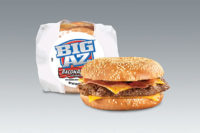Chefs and restaurateurs are culinary curators of our time, collecting recipe ideas and ingredients to create menu items that entice their patrons with the temptation of culinary adventure. There is a lot more happening in restaurants than convenient, quick-service to fuel a busy lifestyle.

According the National Restaurant Association, Washington, D.C., 93% of adult consumers say they enjoy going to restaurants. In fact, dining out is among the great American pastimes, and can mean significant opportunities for companies in the refrigerated and frozen food business.
Restaurant chains are always on the lookout for back-of-the-house efficiency that doesn’t compromise quality. Refrigerated and frozen foods make it easy to consistently deliver homemade taste for some of the most complex flavors. Celebrity chefs are becoming some of the best known brands in the food business, and many of their consumers want to bring the restaurant experience home. Chefs are turning to manufacturers to re-create their signature recipes in refrigerated or frozen formats for retail sale.
Foodies and food traditionalists all crave flavor and are more willing to experiment when dining out. Ethnic flavors that are popular and continue to evolve are Mediterranean, Latin and Asian flavors. Italian cuisine has become a part of classic American menus throughout the country, and the newest Mediterranean flavors that are emerging are from Greece and North Africa. Mexican food introduced heat to the American palate, while Asian cuisines popularized healthy hand-held treats like spring rolls, satisfying noodle bowls and soups like Vietnamese Pho.
There is no denying the appeal of classic American comfort food and its many regional incarnations. In foodservice, comfort food is likely to have a twist that is not easy to replicate at home. For example, macaroni and cheese can be made with a blend of cheeses, a unique pasta shape, the addition of lobster or crab for a special treat or the addition of squash for a jolt of added nutrients.
Looking at the trends that are driving innovation in foodservice, it is important to understand just how much culinary adventure foodservice consumers are seeking. Chefs are often more experimental with their appetizer menus than with their entrées because patrons are more likely to try something new as an appetizer or small plate rather than risk the enjoyment of a favorite entrée.
Small plates are popular choices in foodservice because they feed the never-ending quest for something new and different to try as well as the American appetite for grazing all day long. Smaller portions also give patrons the opportunity to enjoy delicious, flavorful and even exotic foods in reasonable portions. Consumers want to be in control of balancing health and indulgence when they dine out.
Restaurateurs and foodservice operators are likely to welcome refrigerated and frozen foods that allow them to deliver the trends with kitchen-friendly products that deliver made-from-scratch flavor.
To read about retail trends, go to www.refrigeratedfrozenfood.com/retailtrends.
Sharon Olson, executive director
Culinary Visions Panel



